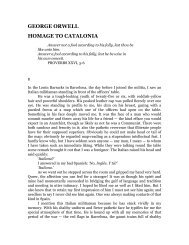Hearth Surgery; The quest for a stove that can save the ... - Studyplace
Hearth Surgery; The quest for a stove that can save the ... - Studyplace
Hearth Surgery; The quest for a stove that can save the ... - Studyplace
You also want an ePaper? Increase the reach of your titles
YUMPU automatically turns print PDFs into web optimized ePapers that Google loves.
<strong>Hearth</strong> <strong>Surgery</strong>; <strong>The</strong> <strong>quest</strong> <strong>for</strong> a <strong>stove</strong> <strong>that</strong> <strong>can</strong> <strong>save</strong> <strong>the</strong> world. <strong>The</strong> New Yorker December 21, 2009<br />
Page 2<br />
GTZ, Scott has designed or built some four hundred thousand <strong>stove</strong>s in thirteen Afri<strong>can</strong> countries. He has made <strong>the</strong>m<br />
out of mud, brick, sheet metal, clay, ceramic, and discarded oil drums. He has made <strong>the</strong>m in villages without electricity<br />
or liquid fuel, where meals are still cooked over open fires, where burns are among <strong>the</strong> most common injuries and<br />
smoke is <strong>the</strong> sixth leading cause of death. In <strong>the</strong> places where Scott works, a good <strong>stove</strong> <strong>can</strong> <strong>save</strong> your life.<br />
He and Andreatta were in Cottage Grove <strong>for</strong> Stove Camp. A mile or two from <strong>the</strong> Axe and Fiddle, a few dozen engineers,<br />
anthropologists, inventors, <strong>for</strong>eign-aid workers, and rogue academics had set up tents in a meadow along a willowy<br />
bend in a <strong>for</strong>k of <strong>the</strong> Willamette River. <strong>The</strong>y spent <strong>the</strong>ir days designing and testing wood-burning <strong>stove</strong>s, <strong>the</strong>ir<br />
nights cooking under <strong>the</strong> stars and debating <strong>the</strong>rmodynamics. Stove Camp was a weeklong event hosted by <strong>the</strong> Aprovecho<br />
Research Center-<strong>the</strong> engineering offshoot of a local institute, education center, and environmental collective. Now<br />
in its tenth year, <strong>the</strong> camp had become a kind of hippie Manhattan Project. It brought toge<strong>the</strong>r <strong>the</strong> best minds in <strong>the</strong> field<br />
to solve a single, intractable problem: How do you build cheap, durable, clean-burning <strong>stove</strong>s <strong>for</strong> three billion people?<br />
A map of <strong>the</strong> world's poor is easy to make, Jacob Moss, a Stove Camper who works <strong>for</strong> <strong>the</strong> Environmental Protection<br />
Agency and started its Partnership <strong>for</strong> Clean Indoor Air, told me. Just follow <strong>the</strong> smoke. About half <strong>the</strong> world's<br />
population cooks with gas, kerosene, or electricity, while <strong>the</strong> o<strong>the</strong>r half burns wood, coal, dung, or o<strong>the</strong>r solid fuels. To<br />
<strong>the</strong> first group, a roaring hearth has become a luxury-a thing <strong>for</strong> camping trips and Christmas parties. To <strong>the</strong> second<br />
group, it's a necessity. To <strong>the</strong> first group, a kitchen is an arsenal of specialized appliances. To <strong>the</strong> second, it's just a place<br />
to build a fire.<br />
Clean air, according to <strong>the</strong> E.P.A., contains less than fifteen micrograms of fine particles per cubic metre. Five<br />
times <strong>that</strong> amount will set off a smoke alarm. Three hundred times as much-roughly what an open fire produces-will<br />
slowly kill you. Wood smoke, as sweet as it smells, is a caustic swirl of chemical agents, including benzene, butadiene,<br />
styrene, <strong>for</strong>maldehyde, dioxin, and methylene chloride. Every leaf or husk adds its own compounds to <strong>the</strong> fire, producing<br />
a fume so corrosive <strong>that</strong> it <strong>can</strong> consume a piece of untreated steel in less than a year. <strong>The</strong> effect on <strong>the</strong> body is similar.<br />
Indoor smoke kills a million and a half people annually, according to <strong>the</strong> World Health Organization. It causes or<br />
compounds a long list of debilities-pneumonia, bronchitis, emphysema, cataracts, <strong>can</strong>cers, heart disease, high blood<br />
pressure, and low birth weight-and has been implicated in a number of o<strong>the</strong>rs, including tuberculosis, low I.Q., and cleft<br />
palate, among o<strong>the</strong>r de<strong>for</strong>mities.<br />
A well-made <strong>stove</strong> <strong>can</strong> easily clear <strong>the</strong> air, by piping <strong>the</strong> smoke out through a chimney or burning <strong>the</strong> fuel more efficiently.<br />
Yet most appliance manufacturers see no profit in making products <strong>for</strong> people who <strong>can</strong>'t pay <strong>for</strong> <strong>the</strong>m. And<br />
most aid agencies have found easier ways to help <strong>the</strong> poor-by administering vaccines, <strong>for</strong> instance. Stovemakers are a<br />
chronically underfunded bunch, used to toiling in <strong>the</strong> dusty margins of international development. Aside from a few<br />
national programs in Asia and <strong>the</strong> Americas, <strong>the</strong>ir projects have tended to be small and scattershot, funded a few thousand<br />
<strong>stove</strong>s at a time by volunteers and N.G.O.s. "We've been watering this rock <strong>for</strong> a long time," Dean Still, <strong>the</strong> head<br />
of Aprovecho, told me.<br />
Lately, though, <strong>the</strong> rules have changed. As global temperatures have risen, <strong>the</strong> smoke from Third World kitchens<br />
has been upgraded from a local to a universal threat. <strong>The</strong> average cooking fire produces about as much carbon dioxide<br />
as a car, and a great deal more soot, or black carbon-a substance seven hundred times as warming. Black carbon absorbs<br />
sunlight. A single gram warms <strong>the</strong> atmosphere as much as a fifteen-hundred-watt space heater running <strong>for</strong> a week.<br />
Given <strong>that</strong> cooking fires each release one or two thousand grams of soot in a year, and <strong>that</strong> three billion people rely on<br />
<strong>the</strong>m, cleaning up those emissions may be <strong>the</strong> fastest, cheapest way to cool <strong>the</strong> planet.<br />
In June, <strong>the</strong> sweeping Waxman-Markey climate bill was passed by <strong>the</strong> U.S. House of Representatives. Hidden<br />
among its fourteen hundred pages was a short section calling on <strong>the</strong> E.P.A. to identify ways to provide <strong>stove</strong>s to twenty<br />
million households in five years. <strong>The</strong> bill made no mention of how or where <strong>the</strong> <strong>stove</strong>s might be built, or who might pay<br />
<strong>for</strong> <strong>the</strong>m. But <strong>the</strong>re was talk of carbon-credit subsidies, international co-financing, and major-appliance manufacturers<br />
entering <strong>the</strong> fray.<br />
<strong>The</strong> engineers of Stove Camp, in o<strong>the</strong>r words, found <strong>the</strong>mselves suddenly blinking in <strong>the</strong> spotlight-like a band of<br />
raccoons caught digging through a scrap heap. "Kill a million and a half people and nobody gives a damn," one government<br />
official told me. "But become part of this big climate thing and everyone comes knocking at your door."<br />
<strong>The</strong> entrance to Stove Camp was marked by a piece of wea<strong>the</strong>red plywood, hung on a rusty railroad trestle, with <strong>the</strong><br />
words "Fred's Island" spray-painted on it. <strong>The</strong> place wasn't technically an island-it was bordered by <strong>the</strong> river on two<br />
sides and <strong>the</strong> railroad on <strong>the</strong> third-but it did belong to a retired carpenter named Fred Colgan. When I arrived on a Sunday<br />
evening, he and Aprovecho's Dean Still showed me an old trailer where I could sleep, a few yards from <strong>the</strong> tracks.









